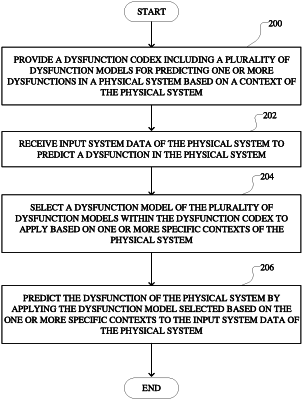| CPC G06N 20/00 (2019.01) [G06N 5/02 (2013.01)] | 18 Claims |

|
1. A method comprising:
generating a plurality of system data clusters from operational data associated with one or more drilling systems of a type of drilling system;
identifying one or more specific contexts of the type of drilling system, wherein the one or more specific contexts identify the type of drilling system and a plurality of dynamic operational characteristics;
generating a plurality of signatures based on the plurality of system data clusters;
providing a plurality of dysfunction models for predicting one or more dysfunctions in a drilling system of the one or more drilling systems based on the one or more specific contexts of the type of drilling system, wherein the one or more specific contexts are associated with the operational data;
generating a first metadata tag associated with a first dysfunction that:
identifies the type of drilling system, and
includes a first signature of the plurality of signatures, wherein the first signature represents a first dynamic operational characteristic of the plurality of dynamic operational characteristics;
generating a second metadata tag associated with a second dysfunction that:
identifies the type of drilling system, and
includes a second signature of the plurality of signatures, wherein the second signature represents a second dynamic operational characteristic of the plurality of dynamic operational characteristics;
tagging the plurality of dysfunction models for predicting the one or more dysfunctions with respective metadata tags that each include at least one of the plurality of signatures, the respective metadata tags associated with the one or more specific contexts of the type of drilling system and including the first metadata tag associated with the first dysfunction and the second metadata tag associated with the second dysfunction, wherein:
the first metadata tag is assigned to at least two related multivariate dysfunction models of the plurality of dysfunction models, and
one or more other dysfunction models of the plurality of dysfunction models are tagged with the second metadata tag associated with the second dysfunction;
selecting a dysfunction model of the at least two related multivariate dysfunction models based on the type of drilling system and the first metadata tag; and
predicting the first dysfunction of the drilling system by applying the selected dysfunction model, wherein:
the selected dysfunction model is applied to predict the first dysfunction while refraining from applying the one or more other dysfunction models that are tagged with the second metadata tag associated with the second dysfunction, and
operation of the drilling system is updated to change the first dynamic operational characteristic based on the prediction of the first dysfunction of the type of drilling system, wherein the change to the first dynamic operational characteristic results in a change to at least one of a flow level, a torque level, or a number of revolutions per minute (RPM) of the drilling system.
|